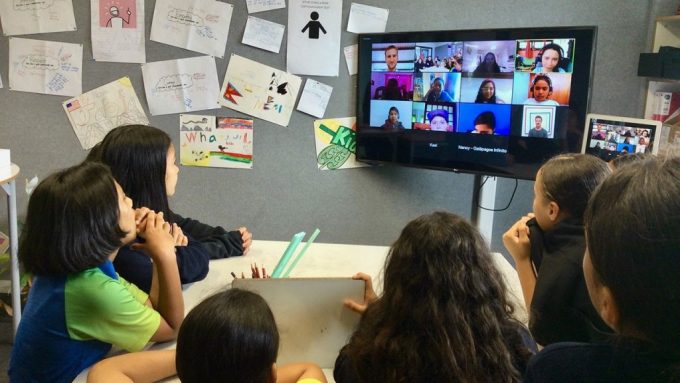
<h2>Two school groups from opposite ends of the Pacific met up online recently to discover each other’s culture and create connections for the future.</h2>
<p>Primary school students aged 10-11 from Kauri Flats School in Takanini and Tomas de Berlanga School, on the island of Santa Cruz in Galápagos, exchanged information about their lives and cultures as a first step towards a greater understanding of their shared environment.</p>
<p>The exchange was part of &#8216;Galápagos Infinito&#8217;, a programme which aims to connect Galápagos children with the ocean in new ways and was conducted with the support of communications organisation Pacifico.</p>
<p>One of the New Zealand organisers of this first school exchange, Professor Carol Mutch from the University of Auckland’s Faculty of Education and Social Work, found out about Pacifico from a colleague in Engineering at Auckland, Vicente Gonzales, who had in turn been contacted by an Argentinian colleague of his, Emiliano Nuesch.</p>
<p>“Vicente told me that Emiliano was trialling a project where children across the Pacific come to understand what they have in common and why it is important to know about and protect the Pacific Ocean and the people that depend on it for the future,” says Professor Mutch.</p>
<p>“Emiliano already had a contact in the Galápagos, a volcanic archipelago notable for its extraordinary wildlife, where they are at risk of rapid urbanisation, environmental degradation and sea level rise. He wanted the children there to talk to children in another area of the Pacific to begin to understand that, while they are different, they have much in common.”</p>
<p>So, Dr Mutch asked Nick Mailau, a teacher at Kauri Flats, if he&#8217;d like his class to participate and the first Zoom meeting was set up. And even though the internet connection was intermittent, the children did get to talk for about an hour, despite speaking different languages, she says.</p>
<p>“The language of Galápagos is Spanish, because the islands belong to Ecuador, but some children spoke a little English and for those who didn&#8217;t, Marta Estelles, who is a visiting scholar from Spain currently being hosted by our Faculty, did the translation.&#8221;</p>
<p>The students from Galápagos were all Zooming in from their own homes as schools are currently closed due to COVID-19. Their teacher, Adrian Benea, started off with a relaxation exercise for everyone, and then the exchange began.</p>
<p>Benea said, “The Kauri Flats students knew that Galápagos has the oldest tortoise in the world, for example and the Tomas de Belanga children knew that New Zealand has snow. After presentations and questions about their cultures, and a waiata from Kauri Flats, the session closed with our students reciting their karakia.</p>
<blockquote>
<p>“Not only did our students come to know about a place they had never heard of, but they came to see that despite their differences, they both live in a set of islands remote from other land.”</p>
</blockquote>
<p>Follow-up meetings will enable students to develop the relationship further and take charge of how they want the cultural exchange to proceed.</p>
<p> ;</p>

Professional learning and development (PLD) for teachers needs to be higher impact for teachers and…
Students displayed increasing AI literacy when explicitly asked to engage with the technology for their…
A new Government collective offer will be voted on by members of NZEI Te Riu…
New Zealand’s education system is a canvas of opportunity to inspire and empower every child.…
When done well, a wellbeing challenge can build habits that support wellbeing for life—and lays…
Te Akatea Inc., the National Māori Principals’ Association has released a discussion paper reflecting on…
This website uses cookies.